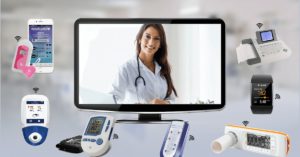Remote monitoring for heart patients gains momentum
Remote heart monitoring, called by many names (telemetry, telecardiology, monitoring, remote patient monitoring, telecardio), has been an integral tool for caring for patients outside of facility settings for a long time, and its application has only grown in recent years as better technologies and infrastructure allow more capable monitoring in a patient’s home. A growing list of technology solutions is now entering the market to support remote cardiac monitoring. These solutions are based on using a couple of electrodes which are either on a device or need to placed on the torso. Especially patch type of solutions for ECG electrodes are now brought to market by significant players such as Philips recently acquired Biotelemetry group.
All these solutions have a focus on arrythmia detection in common. For this purpose just 2 lead or electrodes are already sufficient to produce effective ECG data. And in ECG graph form the focus in on measuring the time between certain incidents in the activation cycle. Beats per minute or duration of specific activation episodes are the key output parameters which are used as input for the analytical algorithms embedded in this remote monitoring solutions.

Easy and better ECG waveform analysis is not there yet
The ease and effectiveness of remote heart monitoring is alas not yet available for ECG waveform analysis. Which is really an unmet need since heart conduction disorders often preceed arrythmia manifestions. Succesfully adressing this challenge can benefit heart disease diagnostics and treatment. And we think this is achievable! Effective remote ECG waveform recording and thus analysis at home requires some simple but hard to achieve requirements:
a) accurate ECG electrodes positioning because these positions impact the shape of the ECG waveform;
b) effective conduction quality during the recording since missing one or two of the key signals recorded by the electrodes closest to the heart have a major impact on the quality of the assessment;
c) an assumption on the relative position of the heart within the patients torso. As the heart is a floating object within the torso the distance between the heart and the electrodes on the torso may vary and again influence the shape of the ECG waveform.
These challenges are the fuel of the work we do at ECG Excellence. There’s more to see in the ECG and effective use of the latest technologies (such as inverse cardiac modelling) support easy and better ECG interpretation.






